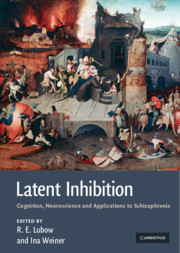1 - A short history of latent inhibition research
Published online by Cambridge University Press: 04 August 2010
Summary
The first latent inhibition (LI) paper was published 50 years ago (Lubow & Moore,1959), and the present book marks that anniversary. As such, it offers a convenient time for providing a historical perspective to a phenomenon that was born by accident, barely survived the first several post-parturitional years, and yet developed into a flourishing research enterprise, with activities cutting across such diverse fields as learning theory, schizophrenia, and even creativity. Indeed, in the weekly episodes of “Prison Break” on American TV, the concept of LI has even reached prime-time television.
In spite of the relatively widespread use of the LI paradigm in the laboratory, and, in particular, because of its adoption in research areas that are far removed from its origins, the present editors felt that there was a need to acquaint the larger audience with both the history and recent advances in LI research and theory.
Before describing the serendipitous discovery of LI, this apparently simple, yet ubiquitous, phenomenon requires a definition and a description of its adaptive function. Specifically, LI is a name for the decrease in the ability to acquire or express a new association to a stimulus that has previously received passive, non-reinforced preexposures, as compared to a stimulus that is either novel (not preexposed) or one that has been reinforced or attended. Importantly, LI is not a process. It is an effect that, as will be seen, is in search of a process that generates it.
- Type
- Chapter
- Information
- Latent InhibitionCognition, Neuroscience and Applications to Schizophrenia, pp. 1 - 20Publisher: Cambridge University PressPrint publication year: 2010
References
- 2
- Cited by



